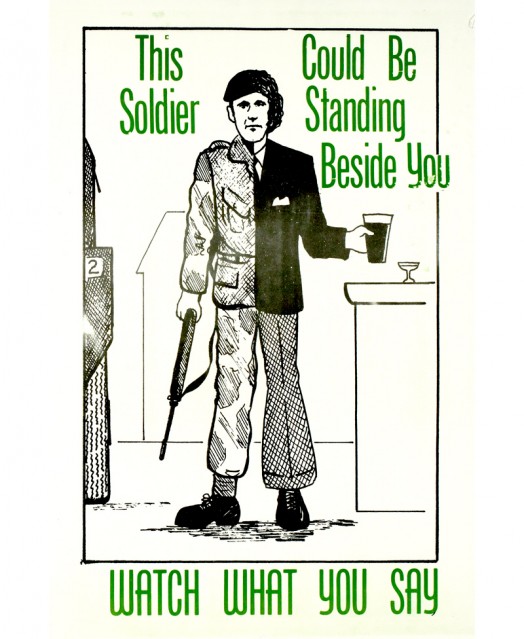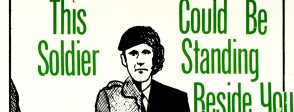
The poster
The poster divides down the centre to show two aspects of the same man. On the right he is drinking at a bar and wearing civilian clothes; on the left he is revealed as a British soldier in uniform. Only the boots are the same. He carries a gun and behind him we see the edge of an armoured car. It carries two captions: ‘This soldier could be standing beside you’ warns people in nationalist areas that someone they meet in a pub could be acting undercover for British Military Intelligence; ‘Watch what you say’ warns people not to give away information in casual talk that could help the enemy. Both aspects of the man would have been familiar to people in Northern Ireland at the time: while pub culture was at the heart of community life, armed soldiers in military vehicles were a common sight in the streets by 1974. The poster reflects the view of the Provisional IRA that theirs was a war of independence against a colonial power. Its echoes of similar 1940s wartime posters characterise their cause as a struggle against an oppressive foreign force that required wider society to be mobilised. The poster appeals to values of solidarity, but may also reflect a concern that army undercover work was having some success.
Why was the British army in Northern Ireland?
By the end of the 1800s, as the pressure for independence from Britain was growing across Ireland, Belfast had become the largest port in Ireland and one of the most important industrial and commercial cities in Britain. It had a strong working class with a Protestant majority who were given preferential treatment over their Catholic neighbours. The power of the Unionist lobby resulted in Northern Ireland staying within the United Kingdom when the rest of Ireland gained independence in 1921. Northern Ireland now had a permanent Unionist majority and a devolved government that sought to maintain Unionist dominance in a climate of mutual distrust between Unionist and Nationalists within Northern Ireland and between the two new states on the island of Ireland. In the early 1960s, influenced by similar campaigns in the USA and South Africa, a predominantly Catholic civil rights movement developed which met with government opposition, aggressive interventions by police and counter-demonstrations by Unionists led by Rev. Ian Paisley. By the end of the decade, the sectarian violence had increased significantly and spread to other parts of Northern Ireland. In 1969 the Labour government in Westminster sent troops to Northern Ireland under Operation Banner.
The army in Northern Ireland
In the first weeks of army presence the troops were welcomed in working class Catholic areas and seen as protectors; this, however, did not last. As inter-community rioting led to injuries and deaths, nationalists began to feel that the army’s policing of the streets was directed unfairly against them and soldiers were increasingly targeted by the IRA seeking to achieve a united Ireland through the use of force. In 1971 the Northern Ireland government introduced internment without trial and rounded up suspected activists, not all of whom had links with the IRA. There were no arrests of Loyalist paramilitaries. Then in January 1972 on ‘Bloody Sunday’ paratroopers opened fire on a peaceful civil rights march in the Bogside area of Derry/Londonderry, killing 13 people (another died later). An investigation exonerated the soldiers. These events led many who had favoured peaceful protest to show more support for the IRA. Over the same period, the heavily destructive IRA bombing campaign - culminating in ‘Bloody Friday’ in Belfast when 9 were killed and 130 injured - confirmed in the eyes of the government and most Unionists their belief that the IRA were dangerous terrorists and a significant threat.
Two months after Bloody Sunday the British government dissolved Stormont and imposed direct rule from Westminster. Talks between the government and the IRA got nowhere. The 1973 Sunningdale Agreement, an attempt at a power-sharing government with an ‘Irish Dimension’ to include Unionists and nationalists, was brought down by unionist political opposition, paramilitary intimidation and mass industrial action by Protestant workers. Meanwhile there was continuing sectarian violence and armed struggle between the Provisional IRA and the army. It was in this context that intelligence gathering by the army, in co-operation with other agencies such as Special Branch and MI5, became an essential and increasingly successful element in countering the IRA and in this context that posters like this one were produced.
Aftermath
The role played by the military on the streets of the British cities of Belfast and Derry/Londonderry remains controversial. Some note that 300 people were killed by soldiers, over half of them civilians, and that whole communities suffered frequent harassment by the army. In 2010 the Saville enquiry established that all the victims on Bloody Sunday were unarmed and the killings unjustifiable, leading to a government apology. It is also argued that Northern Ireland was a test bed for the ‘secret state’ and the reduction of freedoms across the UK. To others, the soldiers were heroic in a difficult situation and at great risk to themselves prevented full scale civil war and the possible break-up of the UK. More than 700 soldiers and other military personnel were killed through paramilitary violence in Northern Ireland, including some 200 members of the Ulster Defence Regiment/Royal Irish Regiment.
More information
Troubled images
Project and exhibition about posters of the political conflict in Northern Ireland.
http://www.culturenorthernireland.org/article/2313/troubled-images
NI timeline activity
Activity using poster sorting to create a timeline of the conflict in Northern Ireland.
http://www.slideshare.net/quillinn/northern-ireland-timeline-activity
The Troubles
BBC History on The Troubles with related links on security forces, violence, Bloody Sunday and Operation Motorman. This site includes a video summary and links to clips from BBC documentaries and news reports.
http://www.bbc.co.uk/history/troubles
University of Ulster Conflict Archive on the Internet (CAIN)
Extensive material on conflict and politics in Northern Ireland.
http://cain.ulst.ac.uk/index.html
CAIN website: the deployment of British troops
http://cain.ulst.ac.uk/events/troops/index.html
Northern Ireland
Comprehensive and well-structured educational website on Northern Ireland with specific sections on the British in Northern Ireland and the Long War.
http://alphahistory.com/northernireland/northern-ireland-topics/
Northern Ireland documents
An extensive selection of documents related to the conflict in Northern Ireland.
http://alphahistory.com/northernireland/northern-ireland-documents/
Slideshow on the Troubles
http://www.theguardian.com/Northern_Ireland/flash/0,6189,344683,00.html
Gordon Gillespie, A short history of the Troubles, Gill & Macmillan Ltd, 2010
http://books.google.co.uk/books/about/A_Short_History_of_the_Troubles.html?id=ykGFPgAACAAJ&redir_esc=y
More information
-
Troubled images
Project and exhibition about posters of the political conflict in Northern Ireland.
Source: culturenorthernireland.org
-
NI timeline activity
Activity using poster sorting to create a timeline of the conflict in Northern Ireland.
Source: slideshare.net
-
The Troubles
BBC History on The Troubles with related links on security forces, violence, Bloody Sunday and Operation Motorman. This site includes a video summary and links to clips from BBC documentaries and news reports.
Source: bbc.co.uk
-
University of Ulster Conflict Archive on the Internet (CAIN)
Extensive material on conflict and politics in Northern Ireland.
Source: cain.ulster.ac.uk
-
CAIN website: the deployment of British troops
Source: cain.ulster.ac.uk
-
Northern Ireland
Comprehensive and well-structured educational website on Northern Ireland with specific sections on the British in Northern Ireland and the Long War.
Source: alphahistory.com
-
Northern Ireland documents
An extensive selection of documents related to the conflict in Northern Ireland.
Source: alphahistory.com
-
Slideshow on the Troubles
Source: theguardian.com
-
Gordon Gillespie, A short history of the Troubles, Gill & Macmillan Ltd, 2010
Source: books.google.co.uk


